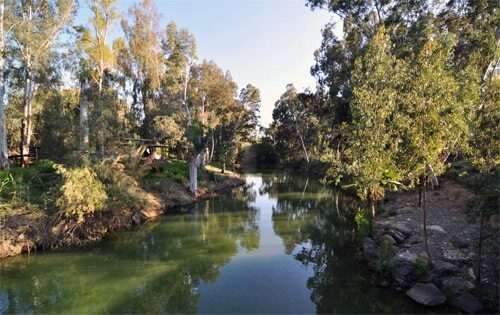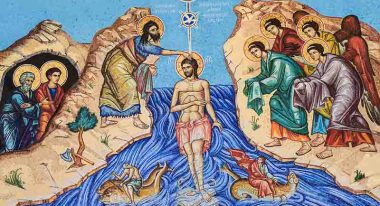
The Jordan River
The River Jordan, in which John the Baptist baptized his cousin Jesus of Nazareth, is a river in Southwest Asia which flows into the Dead Sea. It is considered to be one of the world’s most sacred rivers.
It originates approximately 200 meters above sea level on the slopes of Mt. Hermon, Israel. It ends its course at the lowest spot in the world, the Dead Sea, at 420 meters below sea level. Along its course, the Jordan feeds two lakes: the Hula (now almost completely drained) and the Sea of Galilee. In its course from the Sea of Galilee to the Dead Sea, the Jordan travels a winding 230 kilometers, covering just 105 kilometers in a straight line.
Numerous references to the Jordan River appear both in the Old Testament and the New Testament, indicating its biblical importance and sanctity. In fact, the Jordan is mentioned about 175 times in the Old Testament and about 15 times in the New Testament. The word ‘Jordan’ comes from the Hebrew word ‘Yarden’ {ירדן) meaning descender. This name is appropriate for the river that courses from the heights of Mt Hermon to the depths of the Dead Sea.
In the Bible
The first mention of the Jordan is in the story of the separation of Abraham and Lot. The Bible tells us of Lot’s decision to settle in the Jordan Valley:
“And Lot lifted up his eyes and beheld all the plan of Jordan, that it was well watered everywhere.”
Genesis 13:10
The Jordan appears as the scene of several miracles, the first taking place when Jordan near Jericho, was crossed by the Israelites under Joshua (Joshua 3:15-17). Later the two tribes and the half tribe that settled east of the Jordan built a large altar on its banks as a ‘witness’ between them and other tribes (Joshua 22:10).
In the period of the First Temple, the Jordan was crossed by Elijah and Elisha on dry ground (2 Kings 2:8) Elisha also healed Naaman by having him bathe in its waters.
The river was spoken of as an important defensive weapon (Judges 3:28; 7:24-25; 12:5-6). David escaped across the river during Absalom’s rebellion (11 Sam. 17:20-22).
The Jordan was crossed by Judas Maccabeus and his brother Jonathan Maccabeus during their war with the Nabataeans (1Maccabees 5:24). Later it was the scene of the battle between Jonathan and Bacchides in which the latter was defeated.
In the New Testament
Numerous references to the Jordan River appear in the New Testament. It states that in those days John the Baptist came preaching and saying
“repent, for the kingdom of heaven is near”…and people confessing their sins, they were baptized by him in the Jordan River.
“And so John came, baptizing in the desert region and preaching a baptism of repentance for the forgiveness of sins.”
Luke 3:3“The whole Judean countryside and all the people of Jerusalem went out to him. Confessing their sins, they were baptized by him in the Jordan River”
Mark 1:4-5
In the period of the Second Temple, both John the Baptist and Jesus of Nazareth made their homes here on the banks of the River Jordan.
For hundreds of years, the Jordan remained desolate. Pilgrims and adventurous travelers described the descent to the Jordan, baptism and sailing as one of the most exciting events of their journey in the Holy Land.
In modern times
The region changed dramatically in 1932, when the Naharayim hydraulic plant was built to utilize the water of the Jordan and the Yarmukh rivers to produce electricity. At that time, the Degania dam, located next to the Yardenit Baptismal Site, was constructed. In the 1960s, the water which would normally flow in the Jordan River was diverted via the national water carrier to the densely inhabited central region of Israel. The Jordanians dammed the Yarmukh, a key source of water to the river, diverting its water to the Ghour Channel, on the Jordanian side of the Jordan Rift Valley.
Quality of water
Today there is practically no natural flow of water along the Jordan River. Yardenit is an exception. At the site, the water flows from the Sea of Galilee into the Jordan. The quality of the water at Yardenit is of the same high standard as the water in the Sea of Galilee. The management of Yardenit works together with the Ministry of Health and the Ministry of Water to regularly check the water quality, ensuring that all Pilgrims feel safe while experiencing purification and spiritual rebirth.






